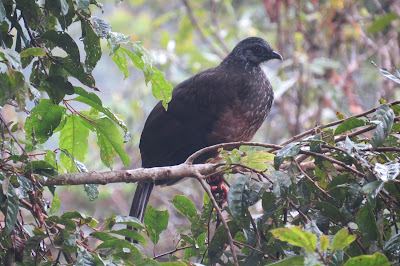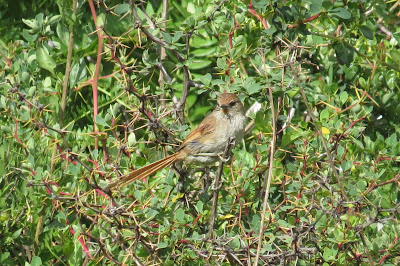CLOUD
FOREST
The cloud
forest includes a wide variety of ecosystems between 600m (1,968 ft.) and
3,500m (11,482 ft). This cloud forest range is a “must” for any wildlife
enthusiast; at least 20 of the 105 endemism of Peru we find here, including
hummingbird feeders.
Located at
2,950m (9,678ft) in the transition area between the high Andean cloud forest
and the grassland of Puna is Wayqecha Biological Station. It is about 700 ha in size and covers a
gradient of 1,200m (3,937ft) in elevation - from 2,300m (7,545ft) to the bottom
to 3,500m (11,482ft) at the top. This gradient allows access to various bird
habitats. The station itself has a
capacity for 50 guests and includes a multipurpose room that serves as a supply
area, conference room and laboratory.
There are 25 km of trails, and a bridge for observation of birds in the
forest canopy, classic birding sites on the highlands and the cloud forest. In
our target list will be Chestnut-breasted Mountain-Finch, Black-throated
Flowerpiercer, Andean Flicker, and more. Our next stop is for the endemic
Creamy-crested Spinetail, and maybe Puna and Diademed Tapaculo, Gray-breasted
Mountain Toucan, Collared Jay and Mountain Cacique, Black-throated
Tody-Flycatcher, White-banded and White-throated Tyrannulets, and the beautiful
Barred and scaled Fruiteaters, chestnut-crested cotinga.
The
Cock-of-the-Rock Lodge is located in the magical Manu cloud forest on the lush
eastern slopes of the Andes, and is part of the Tropical Nature conservation
system. Situated at 1,600m (5,200ft), the lodge protects and supports a 5,060ha
(12,500-acre) private cloud forest reserve. It consists of 12 double-occupancy
wooden bungalows with private bath facilities, and a separate complex with a
large dining room. Here the following birds can be found: Trilling Tapaculo,
Andean Guan, White-rumped Hawk, Chestnut-breasted Coronet, and a wide variety
of Hummingbirds including Collared Inca, Violet-throated Starfrontlet and Amethyst-throated
Sunangel, Purple-backed Thornbill, Scaled Metaltail, White-bellied Woodstar.
Crimson-mantled Woodpecker, Bar-bellied Woodpecker, Pale-footed Swallow,
Mountain Wren, Citrine Warbler and many Tanagers, Scaled Antpitta, Slaty
Gnateater and the endemic Cerulean-capped Mankin, Montane Foliage-gleane.
Possibilities include White-rumped Hawk, Solitary Eagle, Rufous-capped
Thornbill, Crested Quetzal, Golden-headed Quetzal, Masked Trogon, Highland
Motmot, Black-streaked Puffbird, Blue-banded Toucanet, Olive-backed
Woodcreeper, Montane Woodcreeper, Spotted Barbtail, Amazonian Umbrellabird,
Uniform and Variable Antshrikes, Chestnut-crested Cotinga, Scaled Fruiteater,
Bolivian Tyrannulet, Inca Flycatcher (endemic), Peruvian Piedtail (endemic) .
The Manu
National Park (PNM) is located in the provinces of Paucartambo in Cusco and
Manu in Madre de Dios. Its area is 17,162 95.22 hectares. This establishment protects the biodiversity
and landscapes of low jungle, jungle and the Andes of southeastern Peru. Also,
it aims to promote responsible tourism - underpinned by ecological and
culturally compatible criteria. And it extends from the upper 4,000m (13,123ft)
frigid highlands, to 300m (984ft) in the lowland. In its vast territory has
life zone each with its own wildlife, Manu is considered as one of the best
places for the international birdwatchers, Manu has 1,025 species of birds.
The Lodge
is located in the tropical rain forest of the Manu Biosphere Reserve. Amazon
lodge is now considered one of the best places for birding in Peru. This
shelter has 628 species of birds as quickly becoming one of the important
points, Manu Rainforest Peru always take you to the best places in the country
to show without trouble the birds you want to see, such as: Yellow-billed
Nunbird, Swallow-wing, White-throated Jacamar, Lemon-throated Barbet,
Fine-barred Piculet, Crimson-crested Woodpecker, Slender-billed Xenops, Cinnamon-throated
Woodcreeper, Plain-winged Antshrike, Russet Antshrike, sclater's antwren,
Amazonian Streaked-Antwren, Gray Antwren, Warbling Antbird, Rusty-belted
Tapaculo, Ash-throated Gnateater, Black-faced Antthrush, Thrush-like Antpitta,
Short-tailed Pygmy-Tyrant, Olivaceous Flatbill, Gray-capped Flycatcher,
Band-tailed Manakin, Dusky-capped Greenlet, Tawny-faced Gnatwren and the famous
Harpy Eagle and much more.
The
Wildlife Center is strategically located in an area of forest has the highest
diversity of micro-habitats in the area of Manu. This means that there are more
species of animals, reptiles and insects there. An amazing number of birds (575
species recorded) in the refuge have been the focus of studies by renowned
scientists the lodge has 22 double bungalows and a vast network of trails to explore.
That is why many birders who come to Peru give a long sigh when they need to
leave this place.
Birding in
Manu - Peru, in our bird list will be Blue-and-yellow Macaw, Red-and-green Macaw,
White-bellied Parrot, Oilbird, Sand-colored Nighthawk, Pauraque, Ocellated
Poorwill, Pale-winged Trumpeter, Gilded Barbet, Buff-throated Woodcreeper,
Speckled Spinetail, bamboo foliage-gleaner, Bluish-slate Antshrike, Elusive
Antpitta, Manu Antbird, Peruvian Warbling Antbird, Cinnamon Neopipo, and White-crested
Spadebill.
This
stunning, biodiverse area is our private property. We have double bungalows
also have mammal clay lick and a macaw clay lick and a vast network of trails,
the reserve has over 210 hectares, we conserve through the tourism. Is located
300m (984ft) in the lowland, in the Biosphere Reserve of Manu!!Manu Rainforest
Peru, is committed to preserving the ecological reserve is located in the
Biosphere Reserve of Manu, is still virgin forest
As his area
warrants but has yet to be studied, we, as conservationists, welcome scholars
interested in conducting research on our private reserve In turn
Located in
the spectacular route that starts west of the town of Ollantaytambo in the
Sacred Valley, the access road to Abra Malaga goes into the narrow valley of
Tancca River, just above the eastern slopes of the massive Veronica mountain at
5,350m (17,552ft). As you get higher, the road winds through a typical glacial
valley where the bunch grass and herds of llamas dominate the landscape: the
Abra Málaga 4,230m (13,877ft), one step at a great height that allows the road
transpose the Vilcanota mountain range and start the descent into high forest, and
has two types of forests:
Forests
Chusquea bamboo is home to numerous endemic birds such as: Parodi's
Hemispingus, Puna Thistletail, Unstreaked Tit-tyrant, Marcapata Spinetail,
Cuzco Brush Finch, Inca Wren, also add rare birds White-banded Tyrannulet,
Black-eared and Black-capped Hemispingus, White-rumped Hawk, Trilling Tapaculo,
Undulated Antpitta plus a lot more will be in our target list.
The
Polylepis woodland at Abra Malaga Pass
is also one of the best places for bird watching, this forest offers the best
of the best in endemic birds and rare: Stripe-headed Antpitta, Tawny
Tit-Spinetail, Giant Conebill, Andean Tapaculo, Tit -like Dacnis, Blue-mantled
Thornbill, also we'll concentrate to add some endemics on the west side: Royal
Cinclodes, Ash-breasted Tit-tyrant, White-browed Tit-spinetail, Creamy-crested
Spinetail, Rusty-fronted Canastero, White-tufted Sunbeam, Junin Canastero and
Chestnut-breasted Mountain-finch, many more will be in our target bird list.
It is
located in the district of the same name, province of Urubamba, Cusco region,
Republic of Peru. It has an area of 38,448 106 hectares.
It is
nestled in the chain of the Eastern Andes of the Atlantic basin; the Urubamba
River crosses from east to west, forming a deep canyon with altitudes ranging
from 1,750m (5,741ft) to 6,271m (20,574ft) a fact that allowed the development
of special ecosystems and large biodiversity with ten life zones.
In this
area have identified 423 species of birds including the Andean Cock of the
Rock, Andean Condor, Torrent Duck, Sclater's and Bolivian Tyrannulet, Pale-eyed
Thrush, Oleaginous Hemispingus and Capped Conebill, Silver-backed Tanager,
Slaty Tanager, Sword-billed Hummingbird, Slate-throated Whitestart, Hepatic
Tanager, Saffron-crowned Tanager, Xenops Rutilans, and the endemic bird Inca
Wren, Masked Fruiteater, and many more. 342 species of butterflies and 41
species of mammals can be seen, the highlight being the "spectacled
Bear" Tremarctos ornatus. Also in all this areas 309 species of orchids,
506 species of monocots and 979 dicots have been recorded.
As a
corollary of this vast heritage stands above all, the Inca city of Machu
Picchu, the Machu Picchu Center. The Inca City of Machu Picchu, one of the most
extraordinary architectural expressions of civilization; is, according to the
Andean world, the harmonious combination of human work with nature, besides
being the main strategic link between the High Andean region and the Amazon.
Wetland
Huacarpay is located to the east of the valley of Cusco, was formed by a depression during the creation
of the Andes. This wetland is of natural origin, surrounded by a shrub thicket
of dry valley and characteristic aquatic vegetation making a set of ecosystems
that provides food and shelter for many species of resident and migratory
birds. It is located just a 45-minute drive from the city of Cusco, at an
altitude of 3,020m (9,908ft) Here we can spot numerous species of birds
including the Andean Coot, Andean Lapwing, Andean Gull, Andean Flicker,
Streak-fronted Thornbird, Wren-like Rushbird, Many-colored Rush Tyrant,
Spot-billed Ground-Tyrant, Peruvian Sierra Finch, Yellow-winged Blackbird,
Hooded Siskin, White-browed Chat-Tyrant, Yellow-billed Tit-Tyrant,
White-crested Elaenia, Golden-billed Saltator, Blue-and-yellow Tanager,
White-tufted Grebe, Black-chested Buzzard-Eagle, Variable Hawk. High in our
target list are two endemics; the Rusty-fronted Canastero, and the Bearded
Mountaineer Snuff feeding in flowering bushes near the lake.








No hay comentarios:
Publicar un comentario